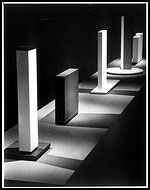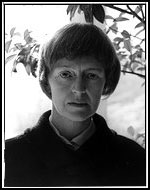|
Vaughan Family Timestream® Maps |
| Home Biography People Places Multimedia: Making It Work On the Water Writings/Presentations |
Anne Truitt
Pillar of the Art Community
Obituary
By Benjamin Forgey
Washington Post Staff Writer
Monday, December 27, 2004; Page C01
Anne Truitt was a presence, modest yet unforgettable.
Something of the same thing can be said for the art Truitt created during five decades of work here in Washington and, on occasion, elsewhere. Art historians will tell us that much of it is important work. Curators already have decided -- pieces by Truitt are in the permanent collections of many of the world's major museums. Yet there is something about Truitt's art that, like the artist, is intensely modest and self-contained.
Truitt, who died Thursday at age 83 of complications following surgery, was a gracious, giving soul. She emphatically took care of the essentials -- raising three children and managing an old frame house in Northwest Washington. She was a handsome woman who wore her considerable erudition without pretension. More than one interviewer silently realized a gap or two in his own education during conversations with her. More important, after just a minute or two of talk, one could not help but be impressed by the subtlety of her character. There was a streak of steel in there, behind the quiet, witty, impatient eyes.
The sculptures that made Truitt famous are big, erect, right-angled boxes, usually taller than human beings. She started making them in Washington in the early 1960s. They were noticed by Clement Greenberg, the powerful New York critic who at the time kept a hand in the Washington art scene, and were shown as a group for the first time in a one-person exhibition at the Andre Emmerich Gallery in Manhattan. The first one-person Washington show was at Ramon Osuna's Pyramid Gallery in 1971.
Those sculptures were, and are, astonishingly direct, seemingly uncomplicated things. You can see them at a glance, walk around them in a flash. They have been linked quite rightly with the beginning of the art style called minimalism, a movement of the 1960s that emphasized basic shapes and industrial materials and processes. For Truitt's everlasting reputation, this is a good thing. Definitely it is helpful to be connected directly to the origin of an artistic style that becomes a chapter heading in art history books.
But Truitt herself frequently disavowed the connection. "Well, if I'm a forerunner, I'm a forerunner without intending to be," she told curator Howard Fox in a 1975 interview. Unlike many true minimalists, she did not make her pieces in accord with a general theory of art. "I did my own work," she said. "I do my own work."
Such fierce, disciplined individualism perhaps has roots in the ways Truitt began making art. Born in Baltimore and raised on the Eastern Shore in Easton, Md., she did not even consider art as a career possibility until well after her graduation in 1943 from Bryn Mawr College with a degree in psychology. She was married and had embarked on family life by the time she began thinking seriously about art.
By then, as she recalled in "Daybook: The Journal of an Artist," an autobiographical rumination published in 1982 (the first of three similar books), the task of fitting this "personal obsession" into her daily life proved to be "tricky." In addition to the demands of child care, she wrote, "I had to fit my own work into a schedule of shopping, cooking, housecleaning, entertaining and, very often, moving from city to city." (Her husband was the late James Truitt, at one time a vice president of The Washington Post. The marriage ended in divorce.)
Clearly, the mom-wife-artist fit required feats of concentration. In "Daybook," Truitt recalled slipping into the studio for 15 minutes "between shopping and carpool." The strain became even greater once Truitt began making works of art that were both big and tremendously original. And making a whole lot of them. In 1962 alone, she recalled, she made more than 30 sculptures. The obsession, as she called it, was becoming ever more demanding.
Throughout, Washington remained Truitt's principal base. Her roots here go back almost to the beginning of modern art in this city. Although she was in many ways self-taught as an artist, she never failed to give credit to the sculptor Alexander Giampietro, who taught her in a novice class in 1948 and 1949 at the now-defunct Institute of Contemporary Art, a pioneering institution that did much to advance the cause of culture in postwar Washington. Although Giampietro was a rather conservative artist, it was under his impassioned tutelage, Truitt wrote, that "I fell in love with the process of art, and I've never fallen out of it."
Of equally lasting importance, it was at the institute that Truitt met Kenneth Noland, the brilliant young painter who would go on to become one of the leading lights of the Washington Color School, a group whose abstract color paintings would lead the art-world limelight to shine oh so briefly on the nation's capital in the 1960s. But though Truitt remembered talks with Noland as highlights of her lonely pursuit of art, she also rejected any attempts to link her too closely to the "school."
Loosely, however, she remains linked, for her emphasis on color and light in her sculptures did in fact develop in the same city at the same time that Noland and others were intensively exploring those same issues on their unprimed canvases. The ideas were in the air, and Truitt cannot have helped but be aware of them. Even so, she was right to insist on her difference, because her works are, indeed, intensively her own.
To really see one of those columnar sculptures, for instance, you cannot just walk around it in a flash. You have to proceed cautiously, to stop, look and think. Then you begin to see little things. You note the precision of the corners, the preciseness of the carpentry. You understand that a certain kind of perfection is the aim. You see the tiny marks of the paintbrush. You notice the slight irregularities of a painted edge, where colors change. You begin to register the differences among the four sides of the piece.
And, if you are lucky and this is one of the best of the pieces and it is displayed in natural light with an opening to the sun, you will begin to absorb the slow, subtle changes of color under differing conditions of illumination. You will at some point be able to step back and see this "simple" object whole, to feel the intensity of vision that it embodies.
The columns are Truitt's signature works, the pieces upon which her reputation will rest for a long time. But the artist made lots of paintings and drawings, and they, too, can be simple-seeming at first and, in the long run, mesmerizingly intense. All of Truitt's art in the end is about the experience of seeing and about what that experience can mean to each of us. Anne Truitt was one of the outstanding artists to have worked in Washington in the last half century, and she left us this not insignificant gift.

